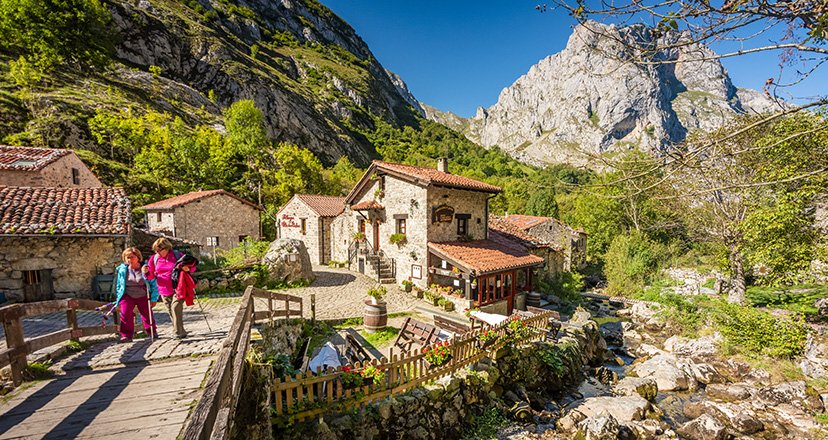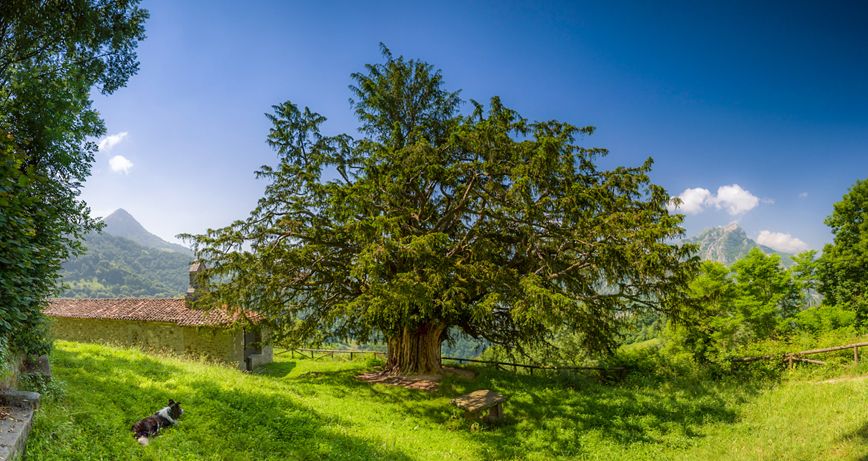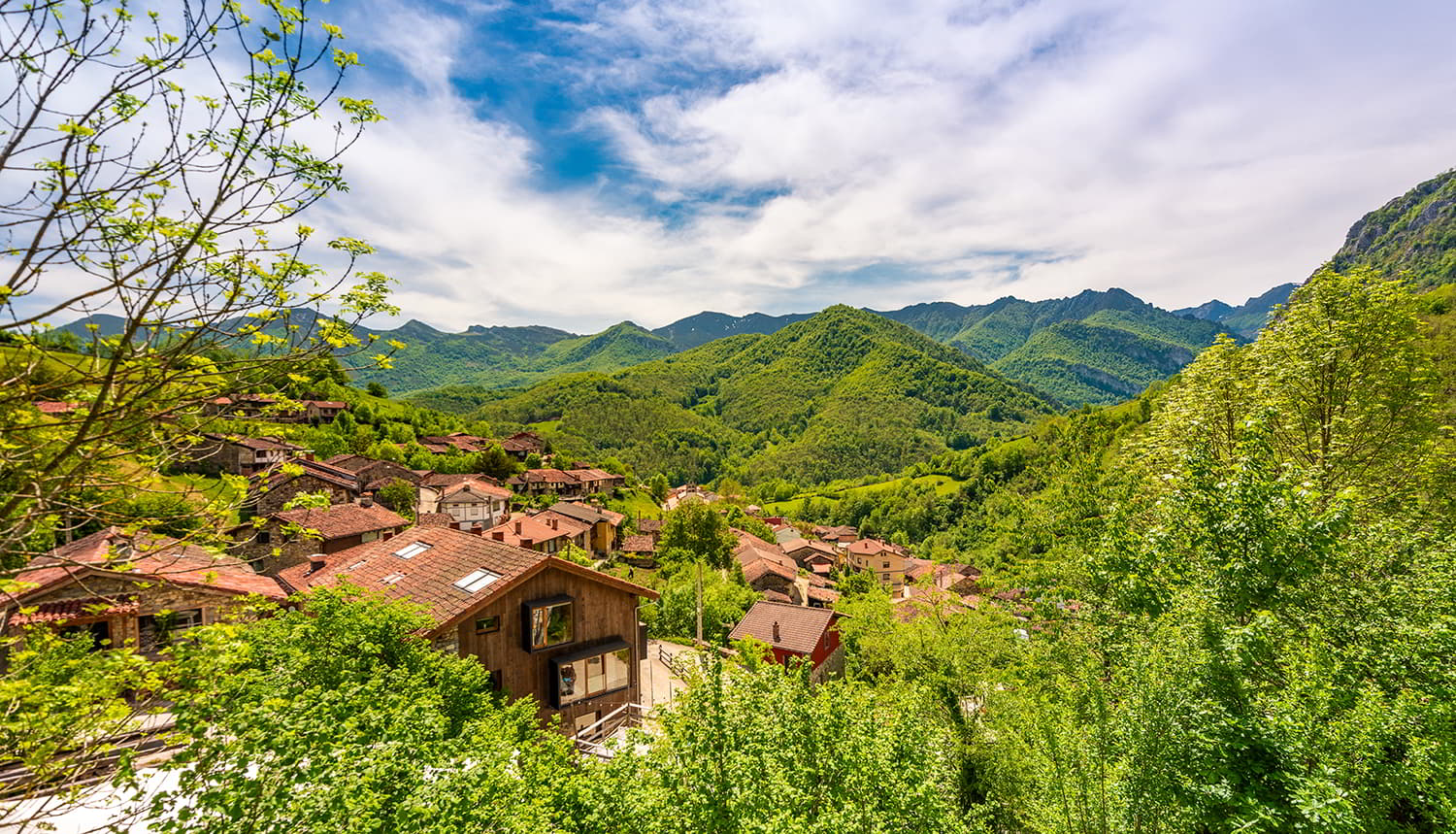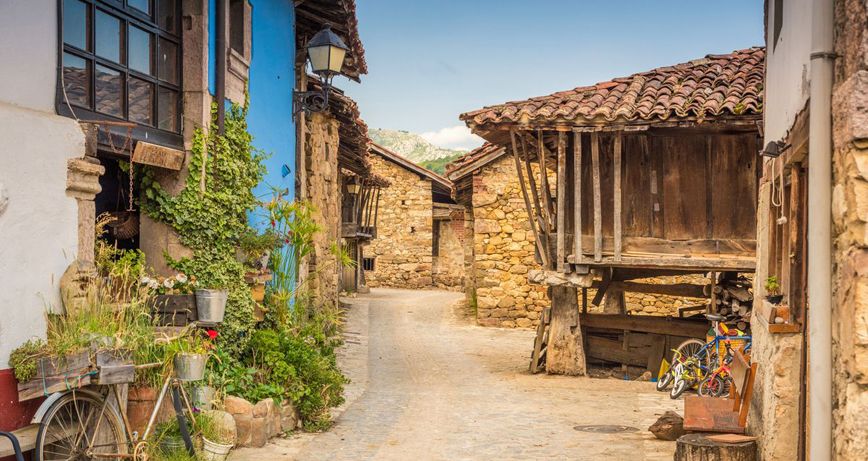Back 10 fairytale villages in Asturias - Part III
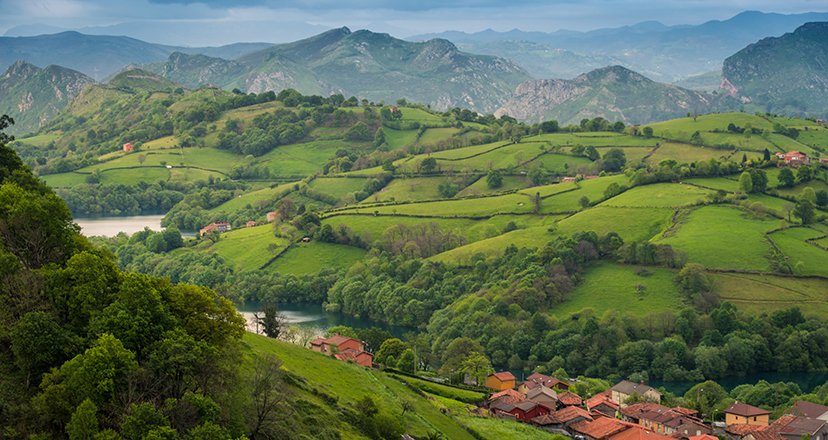
10 fairytale villages in Asturias - Part III
Asturias is a fantastic land, with an infinite number of incredible places. Here are 10 fairytale villages you won't forget.
Asturias is a fairytale land, and as such, it has an infinite number of places and villages that are incredible, as if they were straight out of a fantasy story. There are places at the foot of the mountains, in the midst of ancient forests, on the banks of historic rivers, on the coast, with splendid panoramic views, and some are even a must-see stop on nature and cultural routes.
They are places that speak to us, authentic fairytale villages that are the authors of so many stories that leave us floating in the limbo of the imagination.
Landscapes designed for silence and bustle, for joy and melancholy, for exercise and rest, for sleep and wakefulness. Dreamlike and unrepeatable scenes, which make us feel the protagonists of an irrefutable argument: to be immensely happy in our destiny.
So, to follow these paths of dreams and illusions, we suggest you follow carefully the III part of 10 fairytale villages in Asturias!
Peñerúes: a tower and a reservoir
Peñerúes, in Morcín, preserves one of the most characteristic and famous towers in the whole of medieval Asturias. Although it is currently in ruins, its silhouette, broken by the passage of time and vicissitudes, and projected against the sky at the top of a hill, acquires a special strength and nuances.
The tower of Peñerúes undoubtedly adds to the historical and scenic value of this village, which has seen the passing of time from the serenity of the unstoppable spiral of time. Of Roman origin, it was reformed in the High Middle Ages by King Ordoño I. But be that as it may, today the tower reminds us of where we come from and is a testimony in stone of the resilience of a people.
Furthermore, Peñerúes looks out firmly onto the Alfilorios reservoir, one of the most notable in the centre of Asturias, which supplies water to the Asturian capital, Oviedo/Uviéu, and the surrounding area. In the area surrounding the reservoir, there is a viewpoint from which you can contemplate the Monsacro, a mountain closely linked to the history of the kingdom of Asturias and Christianity.
So Peñerúes exudes history and tranquillity on all four sides.
Aballe, on the banks of a mythical river
Aballe lies on a sweet plain on the banks of the river Sella. Very close to the town of Cangues D'Onís/Cangas de Onís, and belonging to the council of Parres, this village proudly displays its distinction of Exemplary Town of the municipality in 2013.
Aballe is the quietness. With its houses adorned with flowers, and its huts full of granaries and bread baskets, Aballe is a haven of peace, enhanced if possible by the murmur of the Sella, which flows discreetly and slowly along its banks.
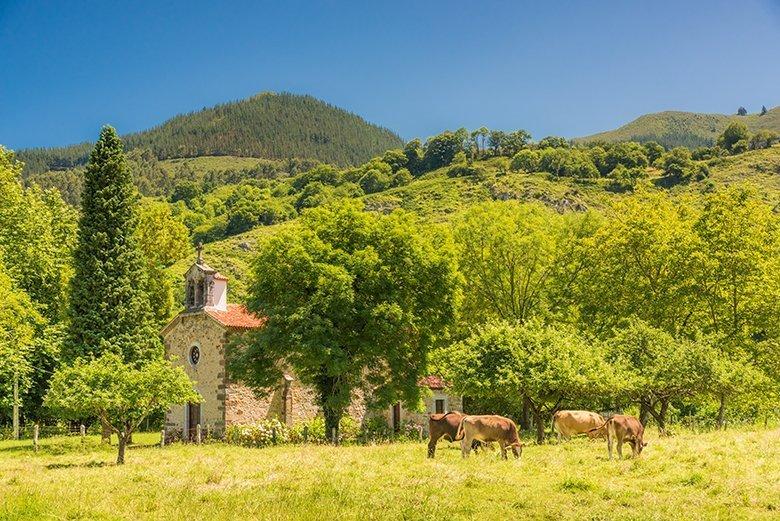
The caleya pitos are happy to roam freely amidst the intense greenery, and the cows do the same. And in the midst of all this rural scenery, the church of Aballe rises up, humble and at the same time powerful, being the anteroom of a small and exquisite river beach that the Sella draws as it passes through the village.
Veneros, the kingdom of wood
If you were to dream of a kingdom of wood, that would probably be Caso, one of the councils that make up, together with Sobrescobio, the Redes Natural Park.
Caso has a human and landscape history that is closely linked to the creation of wooden mills, and the village of Veneros, where the Museum of Wood is located, is proof of this.
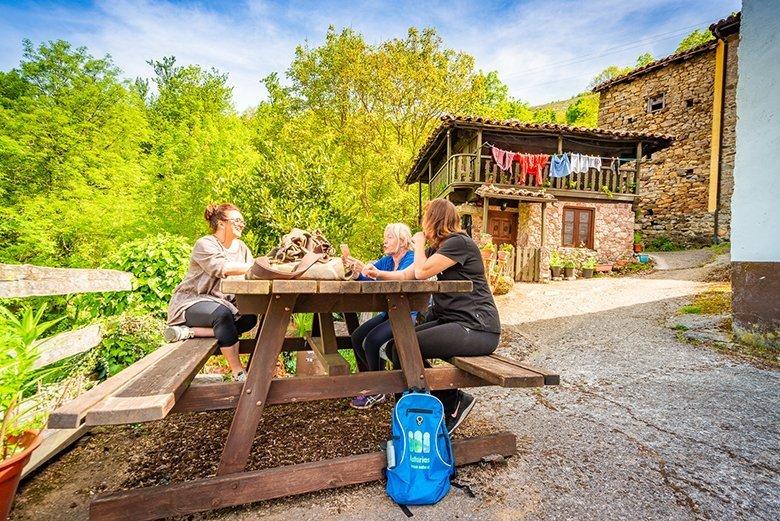
A leisurely stroll through Veneros reveals granaries and granaries, places to sit and relax and chat, while contemplating the lush landscape generated by the longest and most abundant river in Asturias: the Nalón, which flows in the vicinity of this village.
Veneros is a village where craftsmanship has been half of life. A cradle of "madreñeros", the museum itself is a reminder of this activity, which was almost incessant in times gone by.
Niembru, at the foot of a marvellous estuary
The village of Niembru, in Llanes, offers one of the most admired and photographed pictures of all the Asturian landscapes: that of its church and cemetery, at the foot of its estuary.
The estuary and port of Niembru form one of the most beautiful and surprising inlets in the whole of the Cantabrian Sea. At low tide, it becomes a large sandy area, and at full tide, a veritable saltwater pool, ideal for all kinds of water sports.
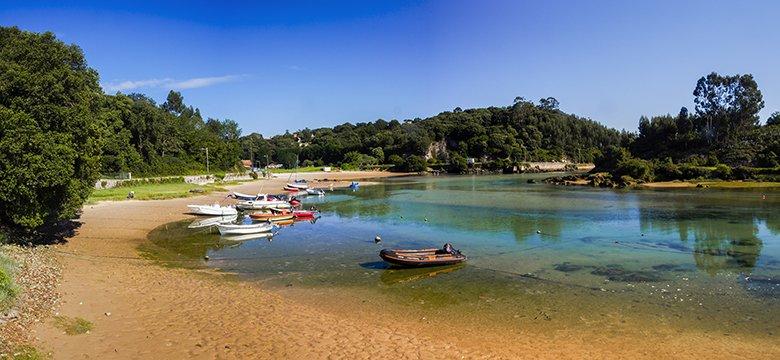
Meanwhile, the village of Niembru is perched on the hillside, contemplating a landscape that will never tire your retina.
The reflection on the waters of the harmonious ensemble of church and cemetery takes on lyrical tints, due to its serene plasticity.
Lliberdón: the village and the piper
Lliberdón is a village in the municipality of Colunga, famous throughout the world for the story of the piper who took the name of his wife's village halfway around the world.
The famous musician, Ramón García Tuero, a native of Villaviciosa, was linked forever to Lliberdón when he married María Carabela. It is precisely here that there is an Interpretation Centre on his history, given that he is one of the most outstanding figures of Asturian music in the late 19th and early 20th centuries, who took the traditions and culture of his land all over the world, performing before the most important personalities of his time.
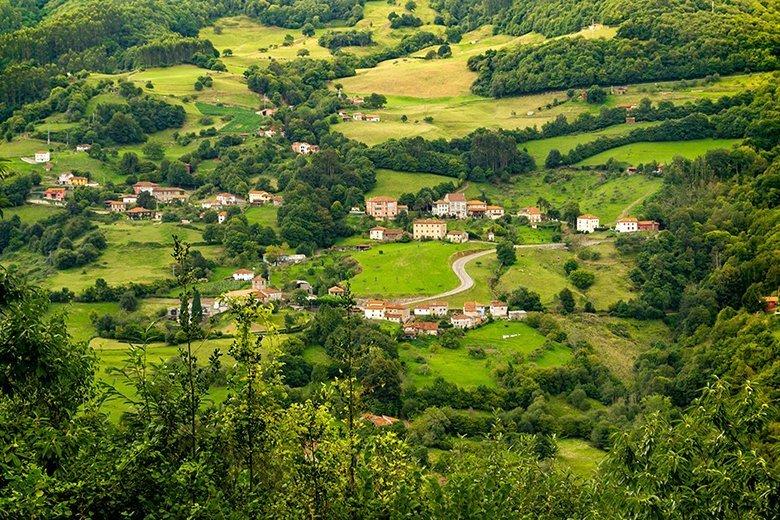
In addition, a stop in Lliberdón will reveal palatial and Indian houses, "chigres" that exude antiquity, stories of mines and mountains, and a church square that is a beauty. And of course, if you go in August, you can't miss the San Roque festivities, where a parade of decorated country carts is held, which is unique in Asturias.
Navelgas: the mecca of golden batting
There is a village in the immense council of Tineo called Navelgas, which today is one of the world references of gold panning (extraction of gold from a flow of water using a pan).
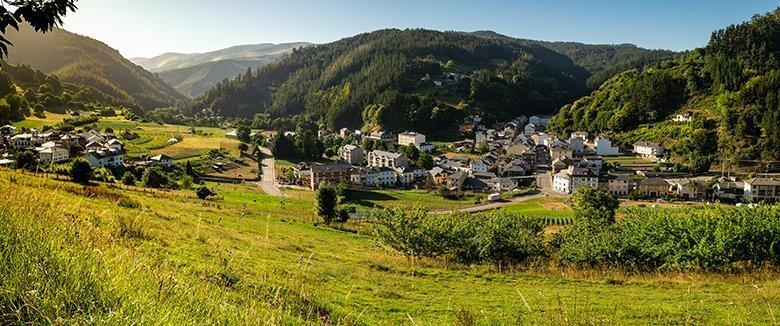
The origin of Navelgas' link to gold goes back to the history of the Roman Empire, which extracted large quantities of this precious metal from western Asturias.
Navelgas preserves all the memory of that fascinating adventure, and is not only the gateway to the Gold Route, but also has a charming museum - at the foot of the river - dedicated to this curious history, where there are also panning activities.
Every summer, this village becomes the capital of gold panning. But at any time of the year it is worth visiting Navelgas, for its lively atmosphere, and because its most historic part is a living testimony of what the villages of western Asturias were like centuries ago.
Coya, the origin of Spanish canoeing
This village in the council of Piloña is a particularly peaceful and idyllic place. Coya seems to have been born for relaxation and rest. So it is no coincidence that it has been and continues to be a village full of holidaymakers during the summer season.
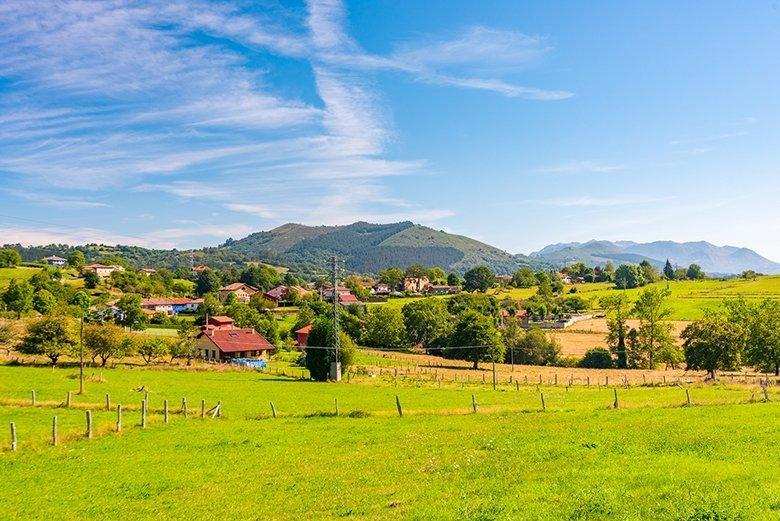
Under the influence of the river Piloña, which flows through the area and forms some of its most emblematic pools, such as the Rabión, Coya is very popular with canoeists, and this is no coincidence either.
Dionisio de la Huerta, the founder of the International Descent of the Sella or Fiesta de las Piragüas, spent all the summers of his childhood and youth here, and it was here where he found the inspiration to make the first descents of the Piloña and the Sella in canoe.
Today you can see from the outside what was once Dionisio de la Huerta's family home, La Huertona, of Indian inspiration, like others in the village.
A very pleasant spot is also the parish church, with its views and its hundred-year-old trees.
San Cristobo, with silence as its banner
A few kilometres from Villanueva de Oscos is the village of San Cristobo. It looks like something out of an old photograph. It is as if the vibrations of time had stopped, and everything in San Cristobo breathes an air of the past, like a kind of carefully and carefully crafted film set.
Perched on a hill, San Cristobo - which forms part of the Silence Route - is a great viewpoint over a valley populated by dense autochthonous woodland. A forest where you enter and find small rivers, waterfalls and cascades, as if it were the home of a family of xanas, goblins, busgosos and nuberos.
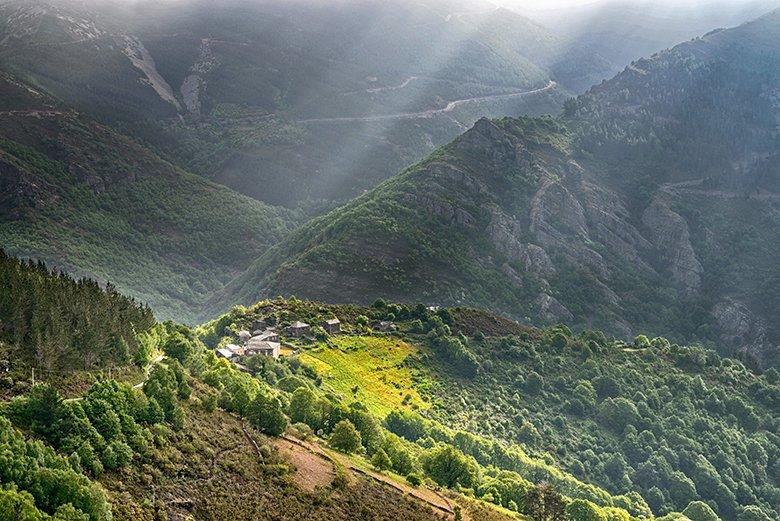
In San Cristobo everything is stillness and silence, it is a kind of metaphor of oblivion carved in stone and black slate... That silence is only broken by your presence and enthusiasm for such a unique place...
Serandías, under the effluvium of the Navia River
The village of Serandías, in Boal, is a great balcony overlooking the river Navia, from which it constantly drinks its effluents. It is therefore not surprising that this village in Boal is a pioneer in the development of active river tourism in western Asturias, thanks to the canoe descents and adventures on this emblematic river.
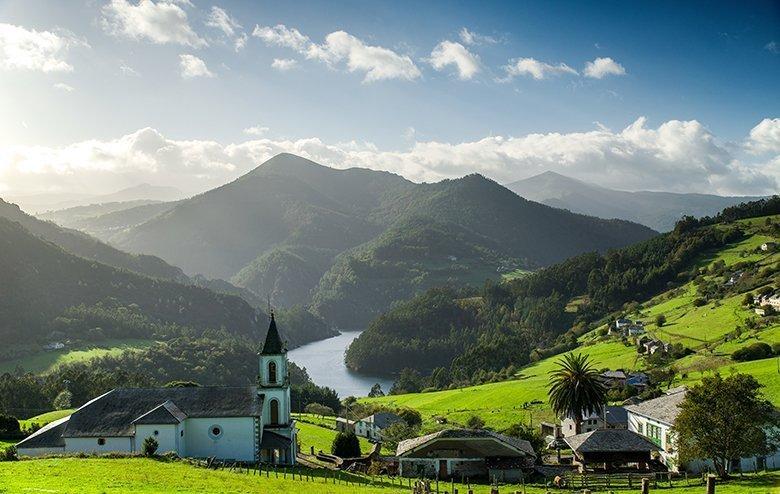
Serandías is one of those places that dazzle you not only for its tranquillity but also for its authenticity. Traditional houses with their black slate roofs, meadows, livestock, or the imposing church tower silhouetted on sunny afternoons against the meandering Navia river and its banks, will give you an idea of the essence of western Asturias.
This is Serandías: a mixture of river and mountain village in the heart of the Navia Historical Park.
Mual, the gateway to Muniellos
Mual, in Cangas del Narcea, stretches out in a narrow, leafy valley, surrounded by forests that feel infinite. The panoramic view of this unique village is particularly striking from La Chalga Peak or from the Montecín viewpoint, two strategic points from which to discover the route of the famous "Puerta de Muniellos" mountain race, which has been held here for more than five years and which has put this village and its local community on the natural, cultural and sporting map.
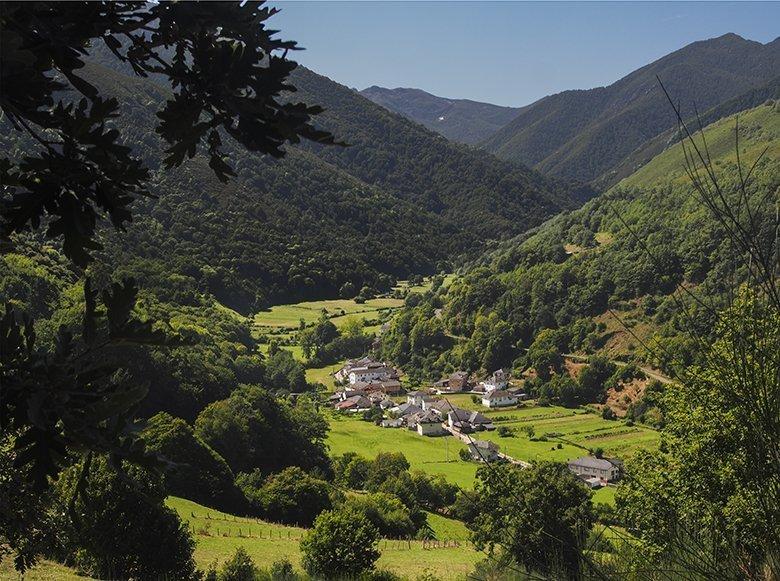
Not in vain, Mual was Exemplary Village of Asturias in 2018, for representing the values of coexistence and respect for nature that make it worthy of such an award.
In Mual not only its people are pleasant, but also the surroundings: the path that leads to the forest of Muniellos and its interpretation centre, the river and its pools ideal for a swim, or the imposing curtains built to protect the honeycombs of the bees from the greedy impulses of the bears...
In short, everything in Mual invites you to a serene immersion in untamed nature.
Asturias is a fairytale land, and as such, it has an infinite number of places and villages that are incredible, as if they were straight out of a fantasy story. There are places at the foot of the mountains, in the midst of ancient forests, on the banks of historic rivers, on the coast, with splendid panoramic views, and some are even a must-see stop on nature and cultural routes.
They are places that speak to us, authentic fairytale villages that are the authors of so many stories that leave us floating in the limbo of the imagination.
|
CLICK TO TWEET: |
Landscapes designed for silence and bustle, for joy and melancholy, for exercise and rest, for sleep and wakefulness. Dreamlike and unrepeatable scenarios, which make us feel the protagonists of an irrefutable argument: to be immensely happy at our destination.
So, in order to follow these paths of dreams and illusions, we suggest that you follow carefully the III part of 10 fairytale villages in Asturias!
Peñerúes: a tower and a reservoir
Peñerúes, in Morcín, preserves one of the most characteristic and famous towers in the whole of medieval Asturias. Although it is currently in ruins, its silhouette, broken by the passage of time and vicissitudes, and projected against the sky on the top of a hill, acquires a special strength and nuances.
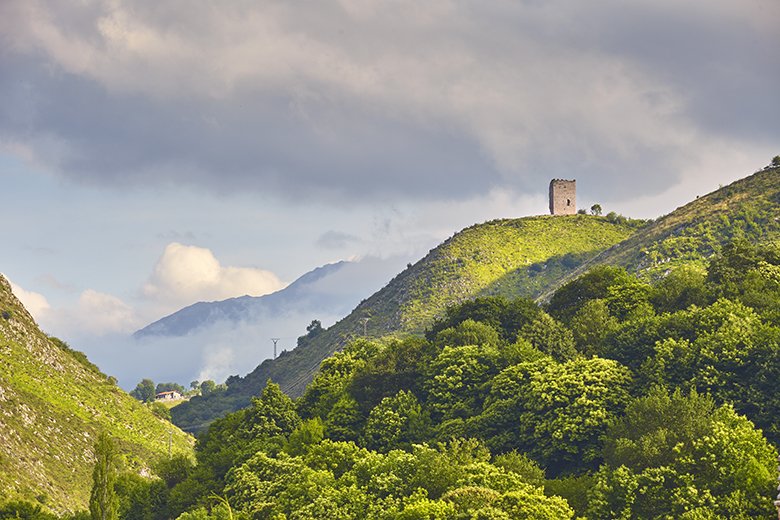
Undoubtedly, the Peñerúes tower adds to the historical and scenic value of this village, which has seen the passing of time from the serenity of the unstoppable spiral of time. Of Roman origin, it was reformed in the High Middle Ages by King Ordoño I. But be that as it may, today the tower reminds us of where we come from and is a testimony in stone of the resilience of a people.
Furthermore, Peñerúes looks out firmly onto the Alfilorios reservoir, one of the most notable in the centre of Asturias, which supplies water to the Asturian capital, Oviedo/Uviéu, and the surrounding area. In the area surrounding the reservoir, there is a viewpoint from which you can contemplate the Monsacro, a mountain closely linked to the history of the kingdom of Asturias and Christianity.
So Peñerúes exudes history and tranquillity on all four sides.
Aballe, on the banks of a mythical river
Aballe stretches out on a sweet plain on the banks of the river Sella. Very close to the town of Cangues D'Onís/Cangas de Onís, and belonging to the council of Parres, this village proudly displays its distinction of Exemplary Town of the municipality in 2013.
Aballe is the quietness. With its houses decorated with flowers, and its huts full of hórreos and paneras, Aballe is a haven of peace, enhanced if possible by the murmur of the Sella, which flows discreetly and slowly along its banks.
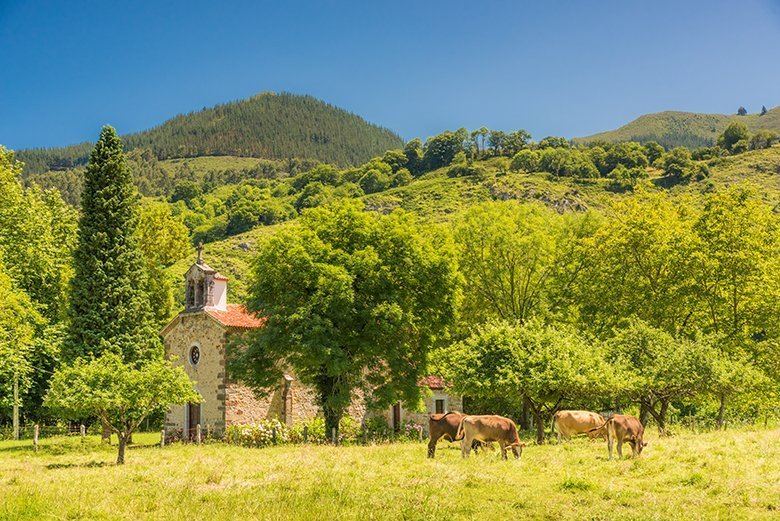
The caleya pitos are happy to roam freely amidst the intense greenery, and the cows do the same. And in the midst of all this rural scenery, the church of Aballe rises, humble and at the same time powerful, being the anteroom of a small and exquisite fluvial beach that the Sella draws as it passes through the village.
Veneros, the kingdom of wood
If you were to dream of a kingdom of wood, that would probably be Caso, one of the councils that make up, together with Sobrescobio, the Redes Natural Park.
Caso has a human and landscape history that is closely linked to the creation of wooden mills, and the village of Veneros, where the Museum of Wood is located, is proof of this.
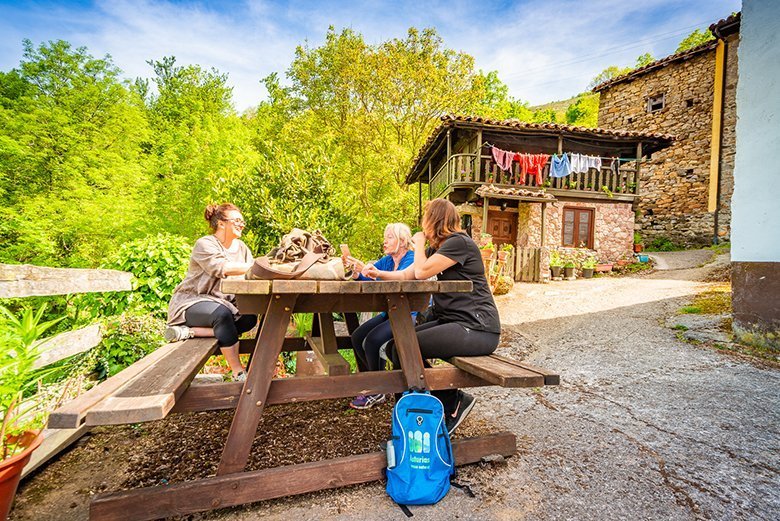
A leisurely stroll through Veneros reveals granaries and granaries, places to sit and relax and chat, while contemplating the lush landscape generated by the longest and most abundant river in Asturias: the Nalón, which flows in the vicinity of this village.
Veneros is a village where craftsmanship has been half of life. It is the cradle of the "madreñeros", and the museum itself is a reminder of this activity, which was almost incessant in the past.
Niembru, at the foot of a marvellous estuary
The village of Niembru, in Llanes, offers one of the most admired and photographed pictures of all the Asturian landscapes: that of its church and cemetery, at the foot of its estuary.
The estuary and port of Niembru form one of the most beautiful and surprising inlets in the whole of the Cantabrian Sea. At low tide, it becomes a large sandy area, and at full tide, a veritable saltwater pool, ideal for all kinds of water sports.
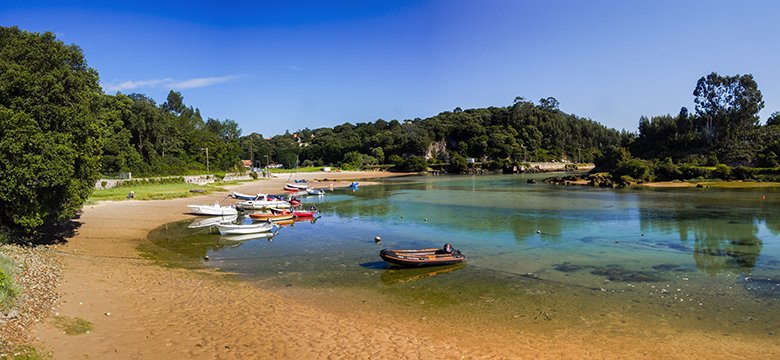
In the meantime, the village of Niembru is perched on the hillside, contemplating a landscape that will never tire your retina.
The reflection on the waters of the harmonious ensemble of church and cemetery takes on lyrical tints, due to its serene plasticity.
Lliberdón: the village and the piper
Lliberdón is a village in the council of Colunga, famous throughout the world for the story of the piper who took the name of his wife's village halfway around the world.
The famous musician, Ramón García Tuero, a native of Villaviciosa, was linked forever to Lliberdón when he married María Carabela. It is precisely here that there is an Interpretation Centre on his history, given that he is one of the most outstanding figures of Asturian music in the late 19th and early 20th centuries, who took the traditions and culture of his land all over the world, performing before the most important personalities of his time.
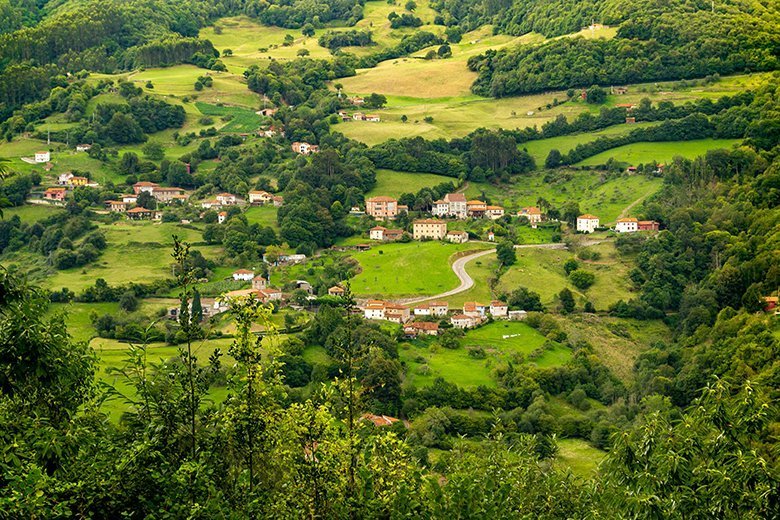
In addition, a stop in Lliberdón will reveal palatial and Indian houses, "chigres" that exude antiquity, stories of mines and mountains, and a church square that is a beauty. And of course, if you go in August, you can't miss the San Roque festivities, where a parade of decorated country carts is held, which is unique in Asturias.
Navelgas: the Mecca of gold panning
There is a village in the immense council of Tineo called Navelgas, which today is one of the world references for gold panning (extraction of gold from a flow of water using a pan).
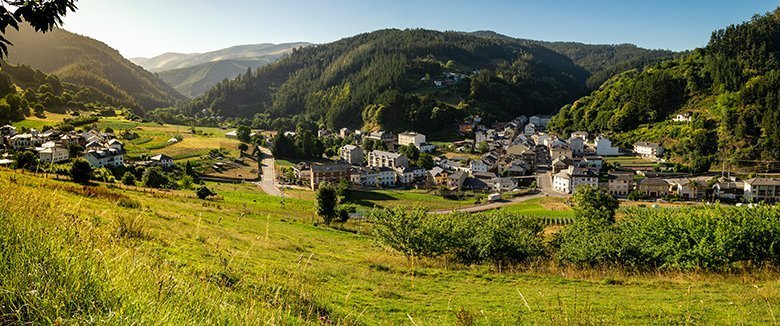
The origins of Navelgas' link with gold go back to the history of the Roman Empire, which extracted a large quantity of this precious metal from western Asturias.
Navelgas preserves all the memory of that fascinating adventure, and is not only the gateway to the Gold Route, but also has a charming museum - at the foot of the river - dedicated to this curious history, where there are also panning activities.
Every summer, this village becomes the capital of gold panning. But at any time of the year it is worth visiting Navelgas, for its lively atmosphere, and because its most historic part is a living testimony to what the villages of western Asturias were like centuries ago.
Coya, the origin of Spanish canoeing
This village in the council of Piloña is a particularly peaceful and idyllic place. Coya seems to have been born for relaxation and rest. So it is no coincidence that it has been and continues to be a village full of holidaymakers during the summer season.
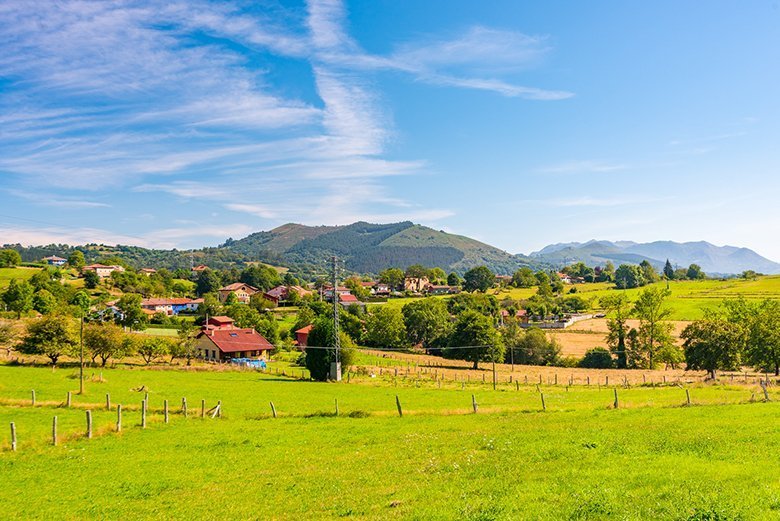
Under the influence of the river Piloña, which flows through it and forms some of its most emblematic wells, such as the Rabión, Coya is very popular with canoeists, and this is no coincidence either.
Dionisio de la Huerta, the founder of the International Descent of the Sella or Fiesta de las Piragüas, spent all the summers of his childhood and youth here, and it was here where he found the inspiration to make the first descents of the Piloña and the Sella in canoe.
Today you can see from the outside what was once Dionisio de la Huerta's family home, La Huertona, of Indian inspiration, like others in the village.
The parish church is also a very pleasant spot, with its views and its hundred-year-old trees.
San Cristobo, with silence as its banner
A few kilometres from Villanueva de Oscos is the village of San Cristobo. It looks like something out of an old photograph. It is as if the vibrations of time had stopped, and everything in San Cristobo breathes an air of the past, like a kind of carefully and carefully crafted film set.
Perched on a hill, San Cristobo - which forms part of the Silence Route - is a great viewpoint over a valley populated by dense autochthonous forest. A forest where you enter and find small rivers, waterfalls and cascades, as if it were the home of a family of xanas, goblins, busgosos and nuberos.
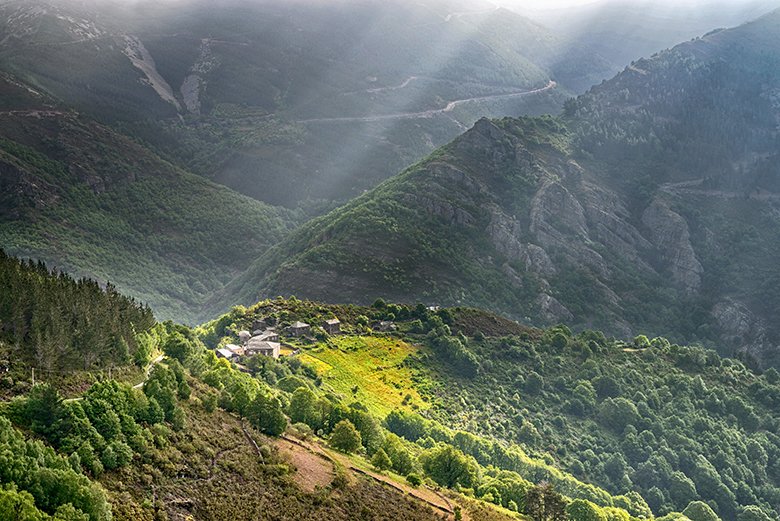
In San Cristobo everything is stillness and silence, it is a kind of metaphor of oblivion carved in stone and black slate... This silence is only broken by your presence and enthusiasm for such a unique place...
Serandías, under the effluvium of the Navia river
The village of Serandías, in Boal, is a great balcony overlooking the river Navia, from which it constantly drinks its effluents. It is therefore not surprising that this Boal village is a pioneer in the development of active river tourism in western Asturias, thanks to the canoe descents and adventures on this emblematic river.
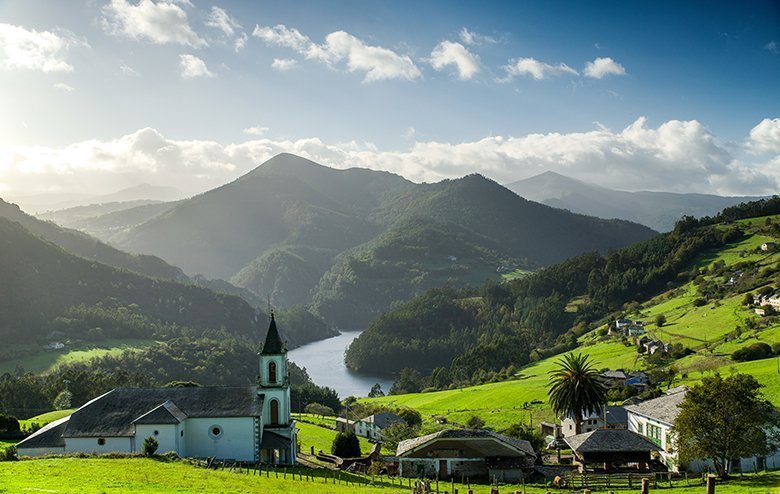
Serandías is one of those places that dazzle you not only for its tranquillity but also for its authenticity. Traditional houses with their black slate roofs, meadows, livestock, or the imposing church tower silhouetted on sunny afternoons against the meandering Navia and its banks, will give you an idea of the essence of western Asturias.
This is Serandinas: a mixture of river and mountain village in the heart of the Navia Historical Park.
Mual, the gateway to Muniellos
Mual, in Cangas del Narcea, stretches out in a narrow, leafy valley, surrounded by forests that feel infinite. The panoramic view of this unique village is especially striking from La Chalga Peak or from the Montecín viewpoint, two strategic points from which to discover the route of the famous "Puerta de Muniellos" mountain race, which has been held here for more than five years and which has put this village and its local community on the natural, cultural and sporting map.
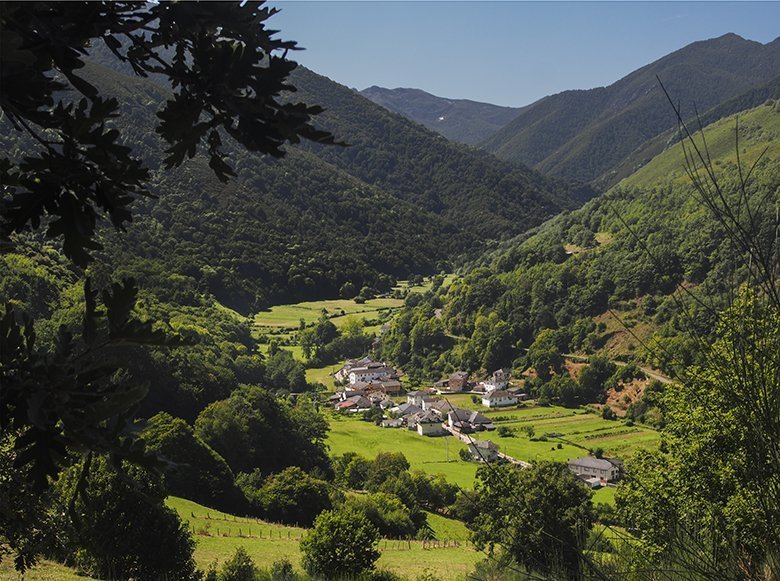
Not in vain, Mual was Exemplary Village of Asturias in 2018, for representing the values of coexistence and respect for nature that make it worthy of such an award.
In Mual not only its people are pleasant, but also the surroundings: the path that leads to the forest of Muniellos and its interpretation centre, the river and its pools ideal for a swim, or the imposing curtains built to protect the honeycombs of the bees from the greedy impulses of bears...
In short, everything in Mual invites you to immerse yourself in a serene immersion in untamed nature.
Travel through these 10 fairytale villages in Asturias and travel endlessly along paths of dreams and illusions! And if you liked this post, share it on your Facebook!
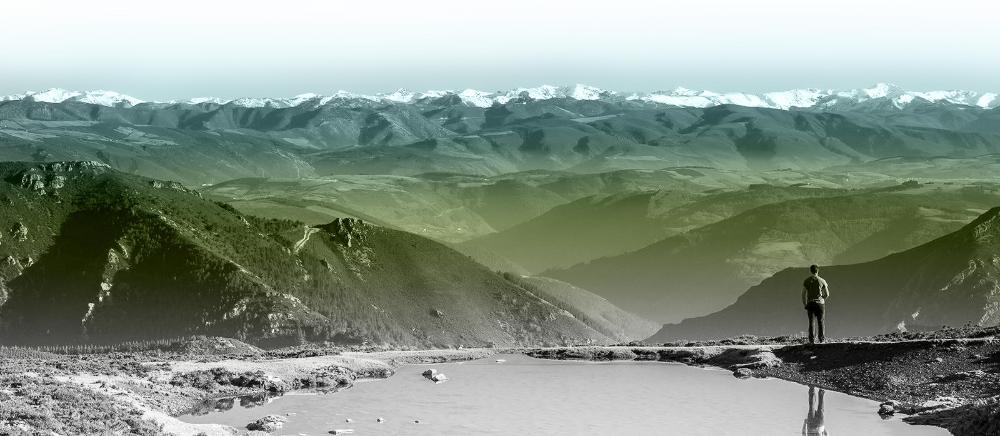
Subscribe to our newsletter and take advantage of offers, discounts, and news
Subscribe


